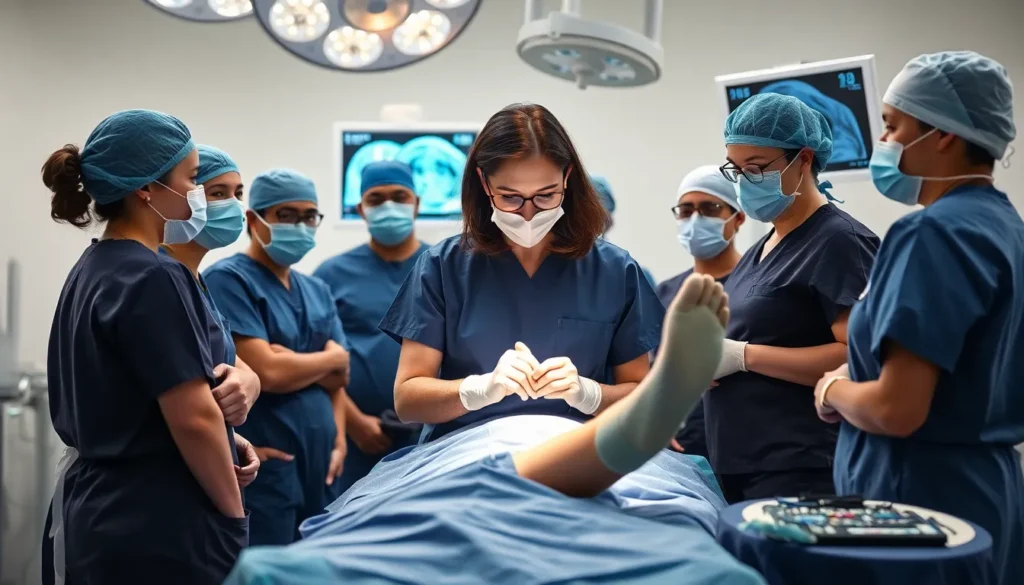Table of Contents
ToggleIn the world of orthopedic surgery, hardware removal surgery is like the final act of a well-rehearsed play. After months of healing, it’s time to bid farewell to those pesky screws and plates that once held everything together. Think of it as a much-needed decluttering session for your body—no more metal detectors at the airport or awkward conversations about your bionic nature!
Overview of Hardware Removal Surgery
Hardware removal surgery involves the extraction of surgical implants like screws or plates after adequate healing has occurred. This procedure provides physical relief and emotional closure for patients.
Definition and Purpose
Hardware removal surgery is a surgical process aimed at excising metal implants that support healing fractures or injuries. The primary purpose focuses on alleviating discomfort caused by the hardware or reducing complications associated with permanent implants. While these devices play a crucial role in stabilization during healing, they may become unnecessary after sufficient recovery. The procedure allows patients to regain full function and comfort, moving forward without the burden of surgical hardware.
Common Indications for Surgery
Common indications for hardware removal include persistent pain or discomfort caused by the implants. Many individuals opt for surgery to address infections that arise around the hardware. In some cases, hardware removal may prevent further complications caused by implant migration or irritation of surrounding tissues. Patients also request this procedure for cosmetic reasons, as visible hardware can be unsightly. Trauma or injury-related factors frequently contribute to the decision, especially when continued athletic activity is desired.
The Surgical Procedure

Hardware removal surgery involves a systematic approach for ensuring patient safety and successful outcomes. This section outlines the crucial steps involved in the preoperative assessment and the surgical techniques used during the procedure.
Preoperative Assessment
Preoperative assessments play a vital role in the surgery’s success. Surgeons evaluate overall health through physical examinations and medical history reviews. Imaging studies, such as X-rays or CT scans, confirm the proper positioning of implants and identify any complications. A discussion of expectations helps clarify potential outcomes, while specific lab tests gauge the body’s readiness for surgery. Patients must communicate any allergies, current medications, or health concerns. This comprehensive assessment minimizes risk and optimizes the surgical plan.
Surgical Techniques
Surgical techniques vary based on the type and location of hardware implanted. Typically, the procedure occurs under local or general anesthesia to ensure patient comfort. Surgeons use advanced imaging techniques to guide precise incisions, allowing access to the implants. Tools like drills, wrenches, or pliers aid in loosening and removing hardware. Techniques prioritize minimal tissue disturbance to enhance recovery and reduce complications. After carefully extracting the hardware, surgeons inspect the site for any damage or infection, ensuring a healthy healing environment. Finally, suturing techniques help to promote optimal recovery.
Risks and Complications
Risks and complications associate with hardware removal surgery. Understanding these elements is essential for informed decision-making.
Potential Surgical Risks
Infection occurs in a small percentage of cases. Bleeding may arise, which often requires additional intervention. Anesthesia complications could manifest, impacting patients differently based on their overall health. Nerve injury is also a concern, potentially resulting in numbness or weakness. Tissue damage during the procedure can occur, affecting recovery time. Fluid accumulation at the surgical site is another risk, which could necessitate drainage. Each of these risks highlights the importance of thorough preoperative assessments and discussions with the surgeon.
Long-Term Complications
Chronic pain after surgery may persist, affecting daily activities. Hardware removal can sometimes lead to changes in joint stability, raising concerns for those engaged in physical activities. Scar tissue formation can limit mobility or cause discomfort in the long run. There’s also the potential for bone healing issues, which might delay recovery. Psychological impacts, such as anxiety surrounding surgery outcomes, affect some patients. Regular follow-ups can help address these complications more effectively and provide reassurance.
Recovery and Rehabilitation
Recovery after hardware removal surgery involves specific strategies to ensure optimal healing and function. Proper care plays a significant role in this process.
Postoperative Care
Following surgery, the care drawn focuses on wound management and pain control. Physicians typically recommend keeping the surgical site clean and dry to prevent infections. Pain medication may be prescribed to help manage discomfort, and he or she may advise the patient to elevate the affected area to reduce swelling. Regular check-ups enable healthcare providers to monitor healing progress. Patients must report any unusual symptoms, like increased redness or drainage, immediately.
Physical Therapy
Physical therapy contributes significantly to rehabilitation. A therapist designs a personalized program that addresses strength, flexibility, and mobility in stages. Early sessions may involve gentle range-of-motion exercises to avoid stiffness. Progressing through resistance exercises strengthens muscles surrounding the joint. He or she encourages consistency to promote recovery and restore function. Patients often notice more confidence during movement as therapy continues. Successful rehabilitation facilitates a return to activities and improves overall quality of life.
Hardware removal surgery marks a significant step toward reclaiming comfort and functionality after orthopedic procedures. By addressing lingering issues associated with surgical implants, patients can experience relief from discomfort and enhance their quality of life. The careful planning and execution of this surgery, along with effective postoperative care and rehabilitation, play crucial roles in ensuring a successful recovery.
As individuals navigate their healing journeys, the benefits of hardware removal extend beyond physical well-being. The freedom from surgical hardware can boost confidence and allow for a more active lifestyle. Ultimately, making informed decisions and maintaining open communication with healthcare providers can lead to positive outcomes and renewed vitality.







